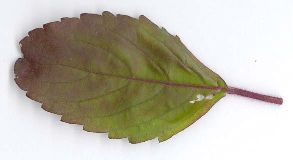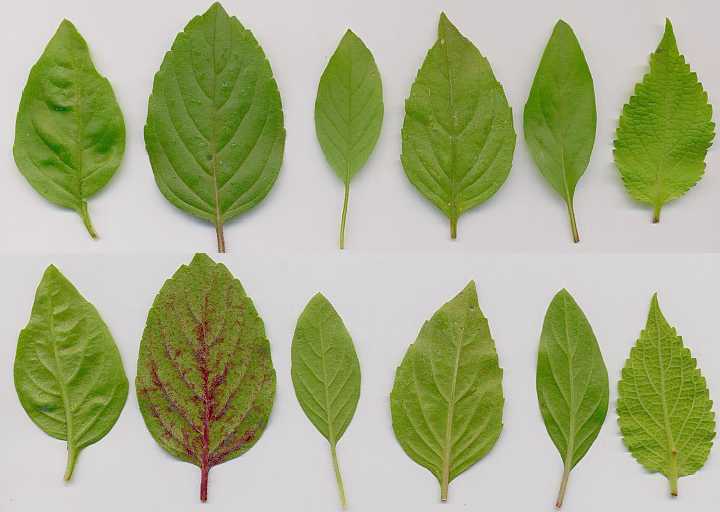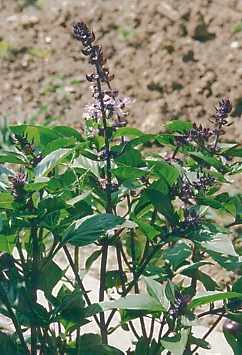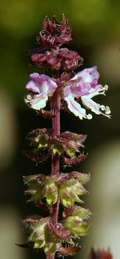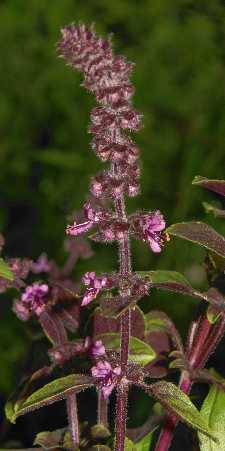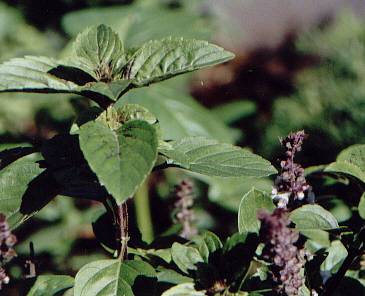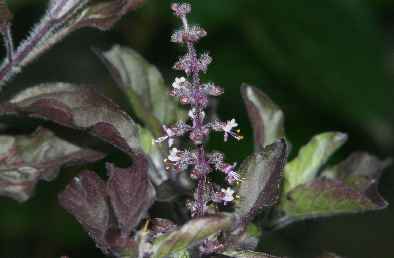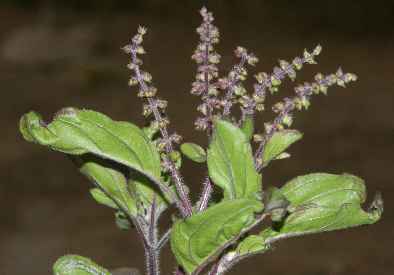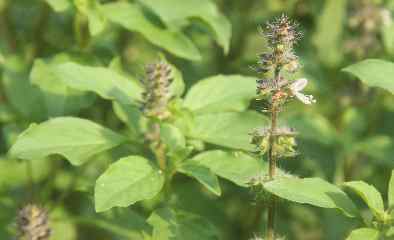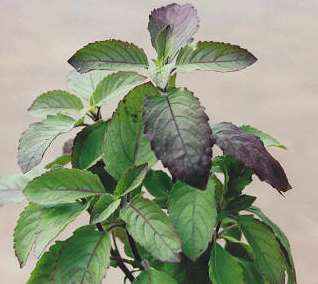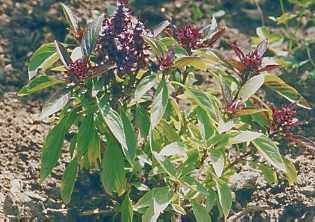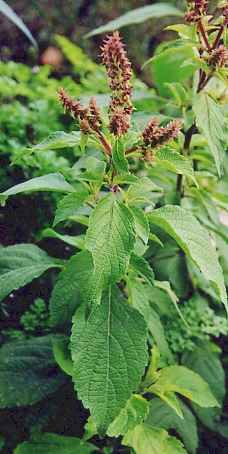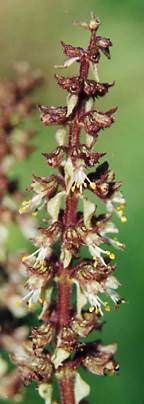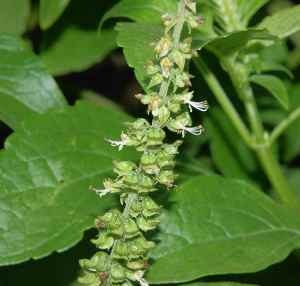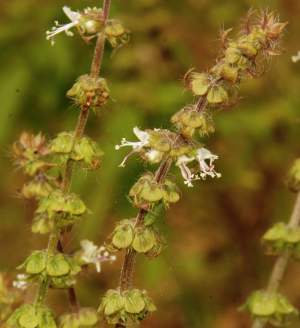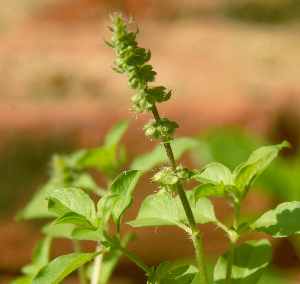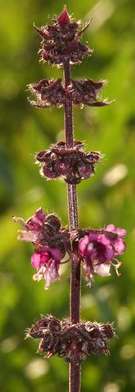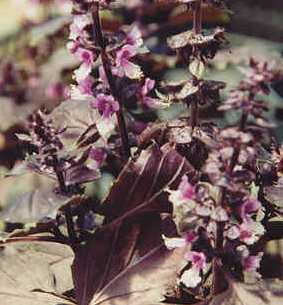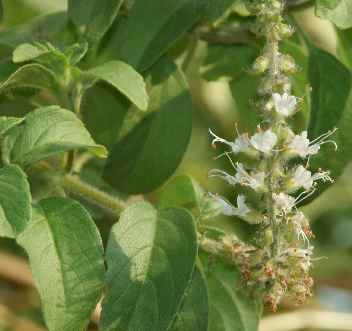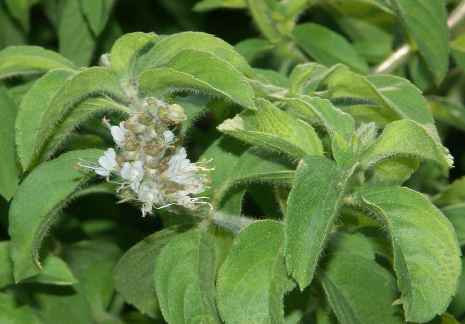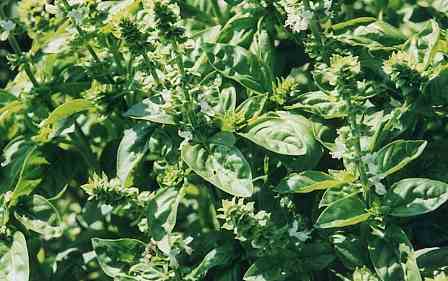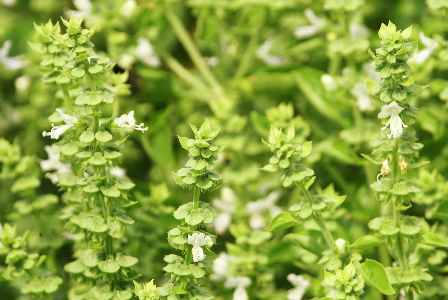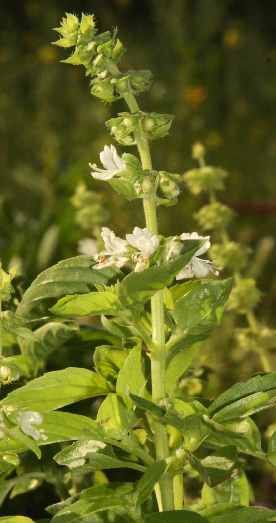
|
| Flowers of basil |
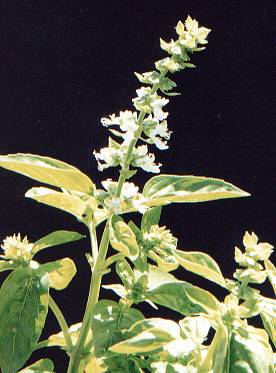
|
| Basil (Mediterranean type, flowering plant) |

|
| Mediterranean basil |
The well-known pesto alla Genovese is a specialty of Liguria, the region in North Western Italy where lovage is native to. That paste is made from fresh basil leaves together with extra vergine olive oil, pine nuts, aromatic local cheese (parmigiano, pecorino sardo) and garlic; a dash of ground cloves might be necessary to improve the flavour of basil not grown under Italy’s hot sun. Pesto is usually served with Italian noodles (pasta). Besides tasting excellent, pesto is also efficient in preserving basil, even without deep-freezer (although it does keep better frozen).
Unfortunately, pesto is very susceptible to enzymatic oxidation by atmospheric oxygen: When exposed to air, it browns rapidly due to oxidation of its phenolic tannins to quinoid polymers. In this process, its flavour is greatly reduced. Susceptibility to oxidation is particularly high if the basil has been puréed too much, or if the pesto has been frozen and rethawed. There is no satisfying way to prevent this degradation: Blanching the basil leaves does inactivate the phenoloxidases responsible for the reaction, but it also destroys most of the flavour. Adding antioxidants or acids also might help but would introduce off-flavours themselves. So, the best way is to consume pesto as quickly as possible, always to keep it covered by a layer of oil, and to keep its container closed during most of the meal.
In southern Italy, the so-called red pesto
pesto rosso is made from sun dried tomatoes,
chiles, olive oil,
cheese, pine nuts and, of course, basil. Due to its natural acidity, it
is much more stable against oxidation.
| ||
|
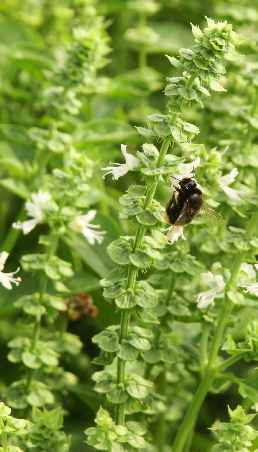
|
| Basil fowers are popular with pollinating insects |
The recipe for pesto can be generalized to other herbs; for
example, pesto made from bear’s
garlic tastes great and also solves the problem of conserving this
spice. Very extravagant pesti can be prepared from chervil or lemon balm.
Frankfurt Green Sauce is an example of a similar sauce
employing a mixture of seven herbs (see borage).
Because of the popularity of pesto, several localized variants
are reported from all over the world, even from Australia (see
Tasmanian pepper about bush food
).
In Italian cuisine, basil is frequently combined with tomatoes, e. g. together with pickled olives, capers and garlic for tasty tomato sauces. Salads made only from tomatoes, extra vergine olive oil, red wine vinegar (see dill about herbal vinegars) and basil are simple but delicious. Basil is, though, less used for meat dishes; Italian cooks prefer oregano for this purpose. Oregano has also succeeded in eclipsing basil as a spice for pizza, although the famous pizza Margherita, which needs basil for reasons of flavour, appearance and patriotism.
Fresh basil may also form part of bouquet garni (see parsley), mostly in Italy and other Mediterranean countries.
Similar use is made of basil in the Far East; it is especially popular in Vietnam and Thailand. Every visitor to Bangkok who dared to try local cuisine will probably never forget the phantastic basil aroma that emanates from nearly every pot at the numerous foodstalls. The basic ideas of Thai cookery are revealed in gai pad kaprao [ไก่ผัดกะเพรา], chicken with chiles and basil: Despite a searing and truly hellish hotness, the dish provides heavenly pleasures by its subtle basil odour.
When using basil in South East Asian
recipes, one should consider that Thai basil tastes rather different from
the Mediterranean herb predominantly available in the
West. Also, care must be taken to choose the right basil;
Thai cuisine is probably the only cuisine that uses three different basil
varieties, each for its own purpose. All three basil varieties should
be available in Thai food stores.
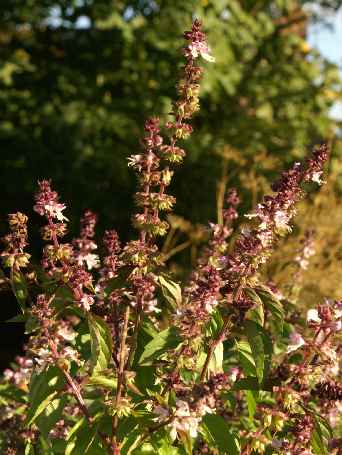
|
| Cinnamon basil is fapp the same as Georgian shashkvlavi. |
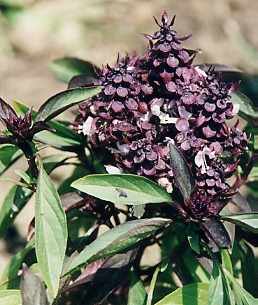
|
| Compact and comparatively large flower clusters are typical for Siam Queen, a Thai basil cultivar suited for growing in temperate climates |
Thai sweet basil (horapha [โหระพา]) is mild and has a fascinating anise flavour somewhat comparable to tarragon, but more intensive. The flavour will not tolerate prolonged cooking. The herb is often sprinkled over Thai food immediately before serving, and it is very good in hot and sour Thai soups (tom yam [ต้มยำ], see kaffir lime) or curries (gaeng [แกง], see coconut); it should not be boiled but just steeped for a minute or two in the hot foods.
Thai sacred basil (kaprao [กะเพรา]) has a pungent taste that is often described as peppery although I find it more like allspice. It is most often used for stir-fries, for example the above-mentioned gai pad bai kaprao, as some cooking is necessary to develop its flavour best. I often find that the kaprao sold in Asian groceries is of poor quality; obviously, it suffers from the transport. Mostly for that reason, some cooks will often substitute kaprao by horapha and change the cooking time accordingly.
There is a third basil variety in Thailand: Thai lemon basil, also known as hoary basil (manglak [แมงลัก]). It has a nice lime flavour and is mostly eaten raw as a garnish; its fresh citrus note goes best with fish.
In Middle Eastern cooking styles, basil plays a minor rôle, although is is commonly planted in gardens and valued for its fragrance. The exception to the rule is the cuisine of Georgia, which is famous for its lavish use of fresh herbs. There, basil is routinely employed for salads and cold appetizers Georgian cooking is so famous for. It is often used in combination with other herbs like parsley, coriander and mint to flavour the great cold appetizers that preceed every Georgian feast. The popular kitri-kamidoris salata [კიტრი-კამიდორის სალათა] made of cucumbers, tomatoes and ground walnuts with loads of garlic may contain any of these herbs. Strangly enough, dried basil is consistently reported as an ingredient for the national herb blend khmeli-suneli [ხმელი-სუნელი] (see blue fenugreek), although the dried plant is known to lose its flavour quickly after drying.
More rarely, a red-
A most interesting basil variety is O. gratissimum
(tree basil, often also called South-East Asian tree basil),
a wild basil distributed over the tropics of Africa and Asia. It has a
very intensive, dominant flavour of cloves,
but is even more pungent. One or two of its large, pubescent leaves are
usually enough for one pot. It will improve almost all
types of savoury foods, from roasted chicken to braised beef, but is has
a particular affinity for meats cooked in red wine.
Despite its powerful fragrance, Indian Sacred Basil is not a culinary plant; all over India, it appears never to be eaten,
although herbal infusions of it are common. Yet, in the North-East Indian union state Manipur, where herbs play a dominant
rôle in cooking (see chameleon herb), there are two types of basil that often get sprinkled over
foods: One is, in its flavour, very close to the
Mediterranean type (mayangton [ময়াংতোন, ꯃꯌꯥꯡꯇꯣꯟ]),
while the other seems virtually identical to the sweet Thai type (nao shek lei [নাওশেক লৈ, ꯅꯥꯎꯁꯦꯛ ꯂꯩ]).
Similarly, a basil type similar to Mediterranean Basil but with an additional lemon scent (sabarang [সাবারাং, 𑄥𑄝𑄢𑄁]) is in use among the Chakma people of North-Eastern India and Bangladesh to flavour vegetable and meat salads.
Mexican spice basil
or cinnamon basil
in the West;
I have not seen it ever used culinarily outside of Georgia.
